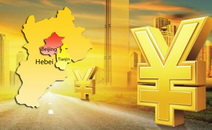Positive Changes Taking Place in China’s Economic Operation -- An Analysis and Outlook of the Economic Situation in 2001-2002
1Calculated according to the data available from January to November.
Second, high-tech industries such as the electronic and telecom products manufacturing industry became the leading force for industrial growth. Since the beginning of the 1990s, new industries including information and bioengineering have registered rapid development and become an important force for the development of the new economy. It also produced diverse impacts on the Chinese economy. The manufacturing of electronic and telecom products and other new industries became a new growth point of the economy. Since 1998, the output value and sales revenue of these industries (excluding the daily electronic products) have been growing at an annual rate of over 30 percent. The manufacturing industry of telecom and related equipment, which accounted for more than 40 percent of the entire industry in terms of output value and sales revenue, saw its sales revenue rise by 43 percent in 2000 and more than 50 percent in the first half of 2001. In December 2001, the electronic and telecom products manufacturing industry accounted for 12.1 percent of the country’s total industrial added value.
Third, the transformation and upgrading of traditional industries became faster. With the intense market competition, the traditional industries such as textile, metallurgy, food, household electric appliance and machine building have all accelerated transformation and upgrading in recent years. The transformation and upgrading involves not only the upgrading of equipment, the improvement of product quality and performance and the diversification of varieties, but also the shifting from the downstream production of consumer products to the midstream and upstream production of spare parts and materials, thus increasing the national contents of these products. These activities greatly increased equipment investment and opened up new areas for the development of the traditional industries. In recent years, the traditional industries such as iron and steel, food and beverage and household electric appliance have all posted steady growth. Their rankings in the entire industry respectively moved from the 6th, 15th, 17th and 12th places in 2000 to the 4th, 9th, 5th and 6th in 2001 in terms of growth rates.2
Fourth, the auto industry’s development became faster. The structural upgrading of urban consumption was playing a visible role in promoting the development of the auto industry. Since 1998, the sales revenue of the auto industry has been growing at an annual rate of more than 16 percent. In the first half of 2001, the growth was as high as 25 percent, next only to the growth of the electronic and telecom products manufacturing industry.
In summary, the space for industrial development has become tangibly larger compared with that of the mid-1990s.
2. The growth of consumer demand was higher and the upgrading of consumption structure became faster.
Since 1998, the growth of consumption and the change of consumption structure in China have all become faster (see the relevant data in tables 2 and 3).
Table 2. Growth of Final Consumption (%)
|
Year |
Comparable growth rate of total retail value of consumer goods |
Comparative growth rateof final consumption |
Final consumption rate |
|
1998 |
7.65 |
7.34 |
58.7 |
|
1999 |
8.32 |
8.67 |
60.1 |
|
2000 |
9.26 |
9.41 |
61.3 |
Note: This table is compiled on the basis of the China Statistical Yearbook 2001. The final consumption and the rate of final consumption originate from the statistics on the total domestic output value, while the total retail value of consumer goods originates from the statistics on domestic trade. The deducted consumer price index is used as the price factor.
Table 3. Structural Change of Urban Consumption (%)
|
Year |
Food |
Clothing |
Household equipments and service |
Medical and health care |
Transport and telecommunication |
Recreation education and culture service |
Housing |
Miscellaneous commodities and service |
|
1995 |
49.92 |
13.55 |
8.39 |
3.11 |
4.83 |
8.84 |
7.07 |
4.28 |
|
1999 |
41.86 |
10.45 |
8.57 |
5.32 |
6.73 |
12.28 |
9.84 |
4.96 |
|
2000 |
39.18 |
10.01 |
8.79 |
6.36 |
7.9 |
12.56 |
10.01 |
5.17 |
Table 4. Structural Change of Rural Consumption (%)
|
Year |
Food |
Clothing |
Housing |
Household equipments and service |
Medical and health care |
Transport and telecommunication |
Cultural, educational and recreational commodities service |
Other commodities and service |
|
1995 |
58.62 |
6.85 |
13.91 |
5.23 |
3.24 |
2.58 |
7.81 |
1.76 |
|
1999 |
52.56 |
5.83 |
14.75 |
5.22 |
4.44 |
4.36 |
10.67 |
2.18 |
|
2000 |
49.13 |
5.75 |
15.47 |
4.52 |
5.24 |
5.58 |
11.18 |
3.14 |
Note: The above two tables are tabulated on the basis of the data concerning the people’s life in the China Statistical Yearbook 2001. All the data are the proportions of various kinds of consumer spending in the total consumer spending.
The above tables indicate that since 1998, the growth rate of consumption has become faster and its proportion in the country’s GDP has also become higher. The structural changes of urban and rural consumption have become quicker. While the proportion of spending on housing, transportation, communications, medical care, education and entertainment has risen, the proportion of spending on food and clothing has declined. In 2001, the growth rate of the total retail value of consumer goods was 9.33 percent at comparable prices, or 0.07 percentage points higher than that in 2000. This is an indication that consumption has continued to grow at a relatively faster pace. The growth of consumption and the upgrading of consumption structure offered an important support for industrial upgrading and industrial expansion. ...
If you need the full context, please leave a message on the website.
May 2002














